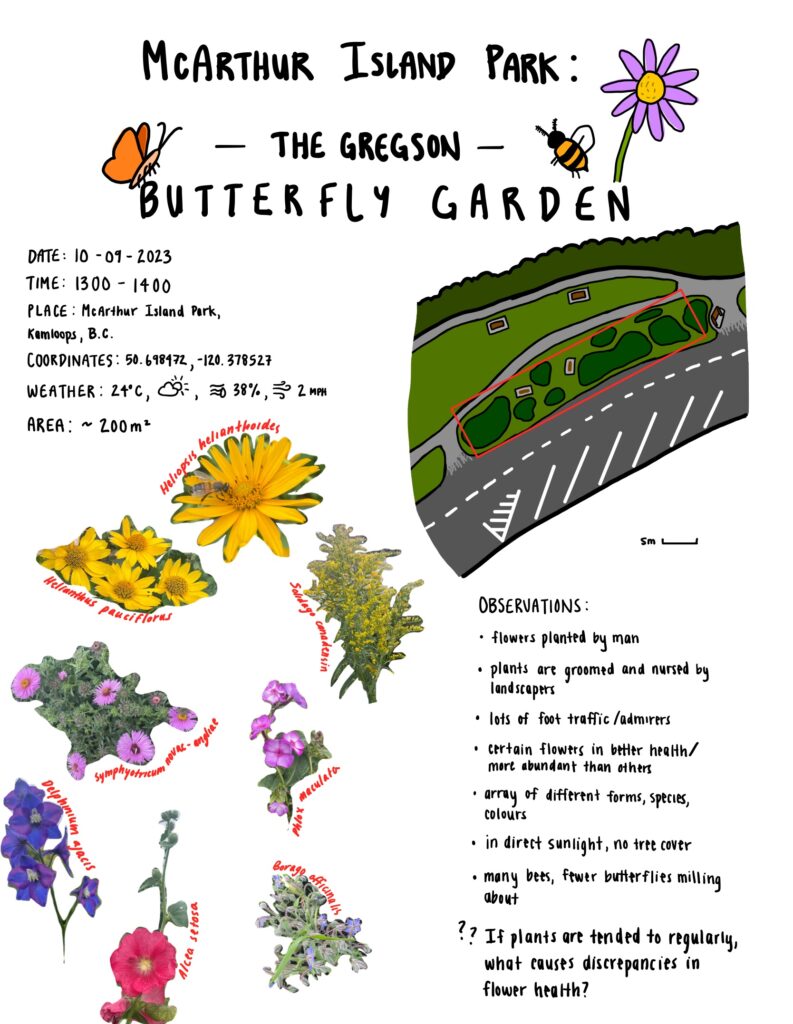I have shifted my focus in terms of ecosystem after going on a walk at McArthur Island Park a week ago and discovering that they have a beautiful butterfly garden! This is my first ecology course, and realized I may have been a bit in over my head with my previous ecosystem selection, as I was looking at more abstract patterns that would have been difficult to run a sound study on. I think simplifying things for myself and doing them really well rather than being overly ambitious and having a faulty design may turn out to be the best option for me. Plus, I get to sit a garden of beautiful flowers for my observations which doesn’t sound bad at all.
I have included my preliminary observations in the image of my field journal, as well as the time, temperature, precise location, and some plant species of interest. In short, I noticed that among certain species of flowers (pieces), there were apparent differences in abundance (pattern). I noticed that flower species with a yellow colour were more abundant, while those that were pink/purple were few and far in between. While there are many mechanisms for why this may (or may not) occur (e.g., temperature/human disturbance/soil quality affecting growth patterns), I wanted to focus on pollinator preference (process), and hypothesized that certain flower colours attract bees and butterflies more than others.
Organisms of Interest:
The organisms that I plan to study are bees and butterflies as pollinators (I’m not sure of the Latin name of the different butterfly species, so I think I will stick with their common names for these two), as well as yellow flowers in the garden (Heliopsis helianthoides, Helianthus pauciflorus, Solidago canadensin), and pink/purple flowers in the garden (Symphyotricum novae-angliae, Phlox maculata, Delphinum ajacis).
Environmental Gradient
Conveniently, the garden is divided into small patches of plant life of which three of them are larger than the others, and they all have at least one yellow flower species, and one pink/purple species. All three areas have the same exposure to the sun. As I mentioned before, all three plots demonstrated a similar pattern of abundance where there were more yellow flowers than non-yellow flowers, and during preliminary and ongoing observations it did seem as though pollinators visited yellow flowers more than non-yellow flowers.
Hypothesis/Prediction
I hypothesize that specific flower colours attract pollinators more than others. If flower colouration affects pollinator preference, then bees and butterflies should visit flower species with a particular colour more than others (regardless of the present environmental gradient).
Experimental Design
Predictor variable: Flower colour (yellow versus pink/purple; categorical)
Response variable: Number of pollinator visits (continuous)
This would be a one-way ANOVA experimental design.
Any feedback would be greatly appreciated, as this is my first time doing a field experiment!

they do have a lovely garden!
really enjoyed the illustrations
yes flower colour seems to be important
https://www.fs.usda.gov/wildflowers/pollinators/Plant_Strategies/visualcues.shtml#:~:text=Plants%20that%20use%20visual%20cues,are%20specific%20to%20particular%20pollinators.
I am wondering if it is getting too late in the year for pollinators? have you seen many? You may want to focus on the mid part of the day of sunnier, hotter days.
you can set or establish a perimeter to observe in, and a time period as well
tip: use ‘humans’ vs ‘man’
Thank you for your feedback! 🙂
During my first observations there was a lot of bees, but butterflies not so much. We are hanging onto the sunshine here, so I think you are right and I will focus on taking my data on warmer days. I may need to speed things up so I can collect data before the sun leaves us for the rest of the year, but I think I can do it!
Amira